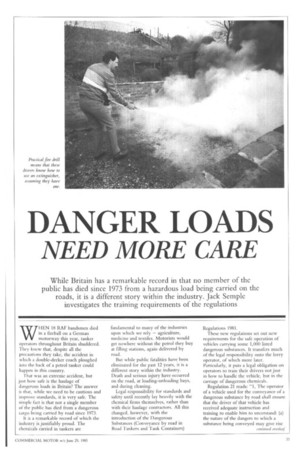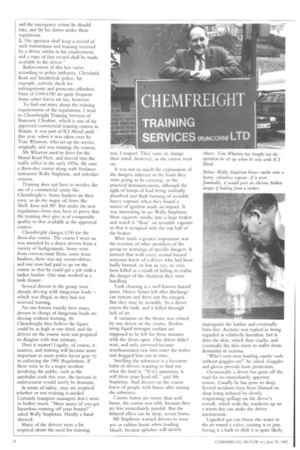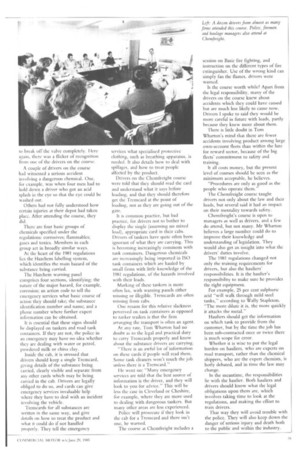DANGER LOADS
Page 35

Page 36

Page 37

If you've noticed an error in this article please click here to report it so we can fix it.
NEED MORE CARE
While Britain has a remarkable record in that no member of the public has died since 1973 from a hazardous load being carried on the roads, it is a different story within the industry. Jack Semple investigates the training requirements of the regulations
WH EN 18 RAF bandsmen died in a fireball on a German motorway this year, tanker operators throughout Britain shuddered. They knew that, despite all the precautions they take, the accident in which a double-decker coach ploughed into the back of a petrol tanker could happen in this country.
That was an extreme accident, but just how safe is the haulage of dangerous loads in Britain? The answer is that, while we need to be cautious and improve standards, it is very safe. The simple fact is that not a single member of the public has died from a dangerous cargo being carried by road since 1973.
It is a remarkable record of which the industry is justifiably proud. The chemicals carried in tankers are fundamental to many of the industries upon which we rely — agriculture, medicine and textiles. Motorists would get nowhere without the petrol they buy at filling stations, again delivered by road.
But while public fatalities have been eliminated for the past 12 years, it is a different story within the industry. Death and serious injury have occurred on the road, at loading-unloading bays, and during cleaning.
Legal responsibility for standards and safety until recently lay heavily with the chemical firms themselves, rather than with their haulage contractors. All this changed, however, with the introduction of the Dangerous Substances (Conveyance by road in Road Tankers and Tank Containers) Regulations 1981.
These new regulations set out new requirements for the safe operation of vehicles carrying some 1,000 listed dangerous substances. It transfers much of the legal responsibility onto the lorry operator, of which more later. Particularly, it puts a legal obligation on operators to train their drivers not just in how to handle the vehicle, but in the carriage of dangerous chemicals.
Regulation 21 reads: "1, The operator of a vehicle used for the conveyance of a dangerous substance by road shall ensure that the driver of that vehicle has received adequate instruction and training to enable him to uncerstand: (a) the nature of the dangers to which a substance being conveyed may give rise and the emergency action he should take; and (b) his duties under these regulations.
2, The operator shall keep a record of such instructions and training received by a driver whilst in his employment, and a copy of that record shall be made available to the driver."
Enforcement of this law varies according to police authority. Cleveland, Kent and Strathclyde police, for example, actively check for infringements and prosecute offenders. Fines of 1004150 arc quite frequent. Sonic other forces are lax, however.
To find out more about the training requirements of the regulations, I went to Cheinfreight Training Services of Runcorn, Cheshire, which is one of six approved commercial training centres in Britain. It was part of ICI Mond until this year, when it was taken over by Tom Wharton, who set up the service originally and was running the courses.
Mr Wharton used to drive for the Mond Road Fleet, and moved into the traffic office in the early 1970s. He runs a three-day course along with freelance instructor Wally Stapleton, and refresher courses.
Training does not have to involve the use of a commercial centre like Chenifreight's. Some hauliers do their own, as do the major oil firms like Shell, Esso and E3P. But under the new regulations firms may have to prove that the training they give is of comparable quality to that available at the approved centres.
Chemfreight charges £.130 for the three-day course. The course I went on was attended by a dozen drivers from a variety of backgrounds. Some were from own-account fleets, some from hauliers; there was one owner-driver, and one man had paid to go on the course so that he could get a job with a tanker haulier. One man worked as a tank cleaner.
Several drivers in the group were already driving with dangerous loads — which was illegal, as they had not received training.
No one knows exactly how many drivers in charge of dangerous loads are driving without training. At Cheinfreight they believe the figure could be as high as one third, and the drivers on the course were not prepared to disagree with that estimate.
Does it matter? Legally, of course, it matters, and training will become more important as more police forces gear lip to enforcing the 1981 Regulations. If there were to be a major incident involving the public, such as the autobahn crash this year, the increase in enforcement would surely be dramatic.
In terms of safety, may are sceptical whether or not training is needed. Certainly transport managers don't seem to bother much. "How many of you get hazardous training off your bosses?" asked Wally Stapleton. Hardly a hand showed.
Many of the drivers were a bit sceptical about the need for training, too, I suspect. They came to change their mind, however, as the course went on.
It was not so much the explanation of the dangers inherent in the loads they were going to be carrying, or the practical demonstrations, although the sight of lumps of lead being violently dissolved and flash burning of invisible heavy vapours when they found a source of ignition made an impact. It was interesting to see Wally Stapleton blow cigarette smoke into a large beaker and watch it "floaton invisible vapours so that it occupied only the top half of the beaker.
What made a greater impression was the reaction of other members of the group to warnings of specific dangers. It seemed that with every second hazard someone knew of a driver who had been badly burned, or lost an eye, or even been killed as a result of failing to realise the danger of the chemical they were handling.
Tank cleaning is a well known hazard point. Heavy fumes left after discharge can remain and drive out the oxygen. But they may be invisible. So a driver enters the tank, and is killed through lack of air.
A variation on the theme was related by one driver on the course. Reefers using liquid nitrogen coolant are supposed to be left for three minutes with the doors open. One driver didn't wait, and only survived because warehousemen saw him enter the trailer and dragged him out in time.
Smelling the substance is a favourite habit of drivers wanting to find out what the load is. "If it's ammonia, it will blow your head off," said Mr Stapleton. And drivers on the course knew of people with burns after tasting the substance.
Caustic burns are worse than acid burns, the course was told, because they are less immediately painful. But the delayed effect can be deep, severe burns.
Mr Stapleton warned drivers to wear pvc or rubber boots when loading bleach, because splashes will slowly impregnate the leather and eventually burn feet. Acetone was typical in being regarded as relatively harmless, but it dries the skin, which then cracks, and eventually the skin starts to suffer from dermatitis or eczema.
"Who's seen men loading caustic soda without goggles on?" he asked. Goggles and gloves provide basic protection.
Occasionally a driver has gone off the road for no immediately apparent reason. Usually he has gone to sleep. Several incidents have been blamed on sleep being induced by slowly evaporating spillage on the driver's overall, which with the windows up on a warm day can make the driver unconscious.
Liquefied gas can freeze the water in the air round a valve, causing it to jam. Giving it a bash to shift it is quite likely to break off the valve completely. here again, there was a flicker of recognition Irons one of the drivers on the course.
A couple of drivers on the course had witnessed a serious accident involving a dangerous chemical. One, for example, was when four men had to hold down a driver who got an acid splash in the eye so that the eye could be washed out.
Others had not fully understood how certain injuries at their depot had taken place. After attending the course, they did.
There are four basic groups of chemicals specified under the regulations: corrosives; flarnmables; gases and toxics. Members in each group act in broadly similar ways.
At the heart of the 1981 regulations lies the Hazchem labelling system, which identifies the main hazard of the substance being carried.
The Hazchem warning panel comprises four sections, identifying: the nature of the major hazard, for example, corrosion; an action code to tell the emergency services what basic course of action they should take; the substance identification number and name; and a phone number where further expert information can be obtained.
It is essential that these signs should be displayed on tankers and road tank containers. If they are not, the police in an emergency may have no idea whether they are dealing with water or petrol, powdered milk or china clay.
Inside the cab, it is stressed that drivers should keep a single Tremcard, giving details of the substance being carried, clearly visible and separate from any other cards which may be being carried in the cab. Drivers are legally obliged to do so, and cards can give emergency services invaluable help where they have to deal with an incident involving the vehicle.
Tremcards for all substances are written in the same way, and give details on how to treat the product and what it could do if not handled properly. They tell the emergency services what specialised protective clothing, such as breathing apparatus, is needed. It also details how to deal with spillages, and how to treat people affected by the product.
Drivers on the Chemfreight course were told that they should read the card arid understand what it says before loading, and that they should therefore get the Tremcard at the point of loading, not as they are going out of the gate.
It is common practice, but bad practice, for drivers not to bother to display the single (assuming no mixed load), appropriate card in their cabs. Drivers of tankers have quite often been ignorant of what they are carrying. This is becoming increasingly commom with tank containers. Dangerous chemicals are increasingly being imported in ISO tank containers which are hauled by small firms with little knowledge of the 1981 regulations, of the hazards involved with their loads.
Marking of these tankers is more often lax, with warning panels either missing or illegible. Tremcards are often missing from cabs.
One resaon for this relative slackness perceived on tank containers as opposed to tanker trailers is that the firm arranging the transport is often an agent.
At any rate, Torn Wharton had no doubt as to the legal and practical duty to carry Tremcards properly and know about the substance drivers arc carrying.
"There is an awful lot of information on these cards if people will read them. Sonic tank cleaners won't touch the job unless there is a Tremcard."
He went on: "Many emergency services are told that the best source of information is the driver, and they will look to you for advice." This will be less the case in Cleveland or Cheshire, for example, where they are more used to dealing with dangerous tankers, But many other areas are less experienced.
Police will prosecute if they look in the cab for a Tremcard and there isn't one, he warned.
The course at Chemfreight includes a session on Basic fire fighting, and instruction on the different types of fire extinguisher. Use of the wrong kind can simply fan the flames, drivers were warned.
Is the course worth while? Apart from the legal responsibility, many of the drivers on the course knew about accidents which they could have caused but are much less likely to cause now. Drivers I spoke to said they would be more careful in future with loads, partly because they knew more about them.
There is little doubt in Tom Wharton's mind that there are fewer accidents involving product among large own-account fleets than within the hire for reward sector, because of the big fleets' commitment to safety and training.
It all costs money, but the present level of courses should be seen as the minimum acceptable, he believes.
"Procedures are only as good as the people who operate them."
The Chemfreight course taught drivers not only about the law and their loads, but several said it had an impact on their mentality towards safety.
Chemfreight's course is open to managers as well as drivers, and a few do attend, hut not many. Mr Wharton believes a large number could do to improve their knowledge and understanding of legislation. They would also get an insight into what the drivers' duties involve.
The 1981 regulations changed not only the training requirements for drivers, but also the hauliers' responsibilities. It is the haulier's responsibility to make sure he provides the right equipment.
For example, 25 per cent sulphuric acid "will walk through mild steel tanks," according to Wally Stapleton. "The more dilute it is, the more quickly it attacks the metal."
Hauliers should get the information on which tank to provide from the customer, hut by the time the job has been sub-contracted once or twice there is much scope for error.
Whether it is wise to put the legal burden on hauliers, who are experts on road transport, rather than the chemical shippers, who are the expert chemists, is hotly debated, and in time the law may change.
in the meantime, the responsibilities lie with the haulier. Both hauliers and drivers should know what the legal obligations upon them are, which involves taking time to look at the regulations, and making the effort to train drivers.
That way they will avoid trouble with the police. They will also keep down the danger of serious injury and death both to the public and within the industry.




































































































